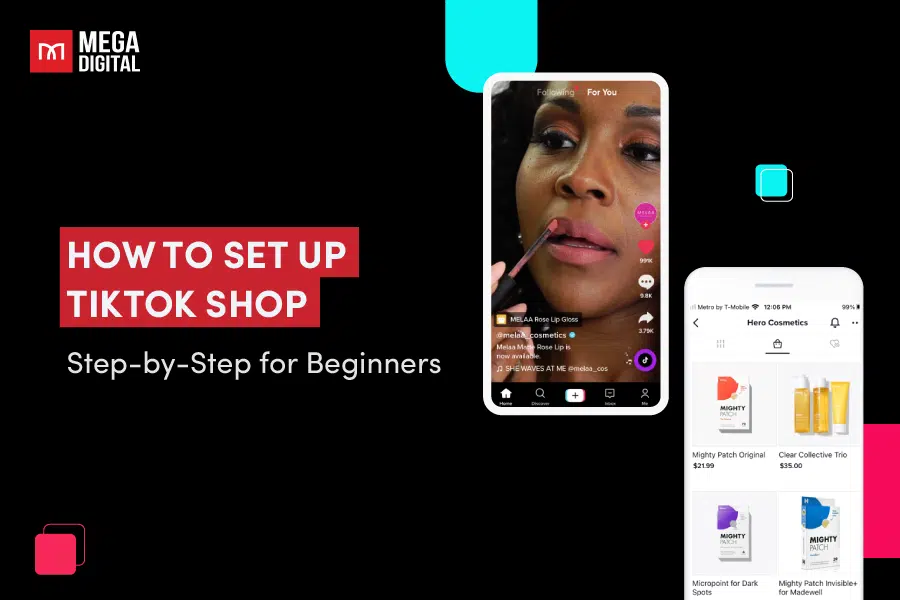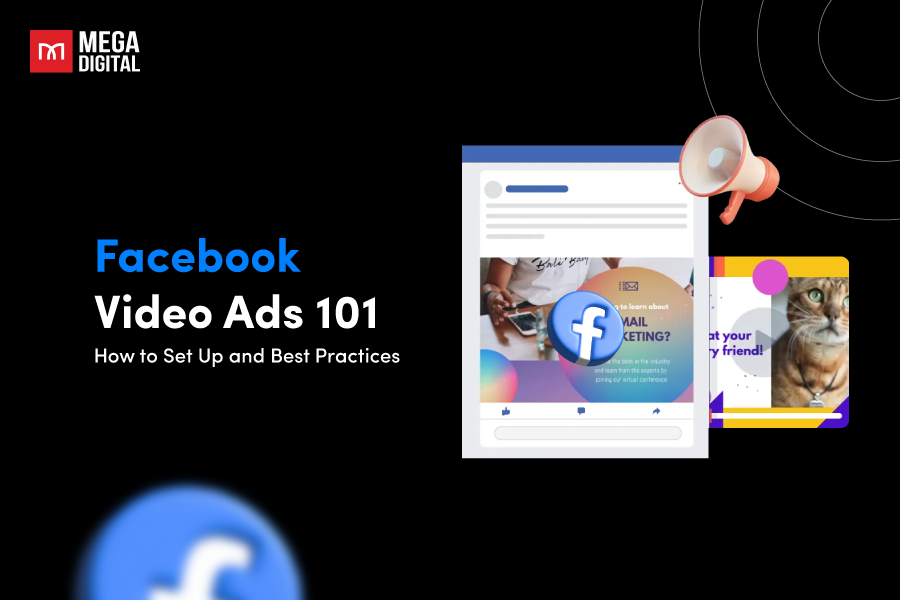As an indie artist, you’ve poured your heart into your music. But is your online presence strong enough? In today’s digital music landscape, promoting your work online is essential. Google Ads for Musicians provides a platform to reach listeners globally.
Be sure to read the entire blog; I assure you you’ll find something new and valuable.
- Why Google Ads for Musicians?
- Which Ad Type is Recommended for Musicians?
- Is YouTube A Good Platform For Musicians?
- How Much Does It Cost Musicians to Advertise on Google Ads?
- How to Run YouTube Ads for Music Videos?
- How to Optimize Your Music Video YouTube Advertising Campaign?
- YouTube Ads for Musicians Examples
Why Google Ads for Musicians?
YouTube Shorts attracts 1.5 billion users per month, with the platform receiving 50 billion daily views. Using music promotion through Google Ads means tapping into this massive audience. The majority of these viewers are Gen Z, who have a preference for short videos, making this platform an excellent opportunity for finding new fans.
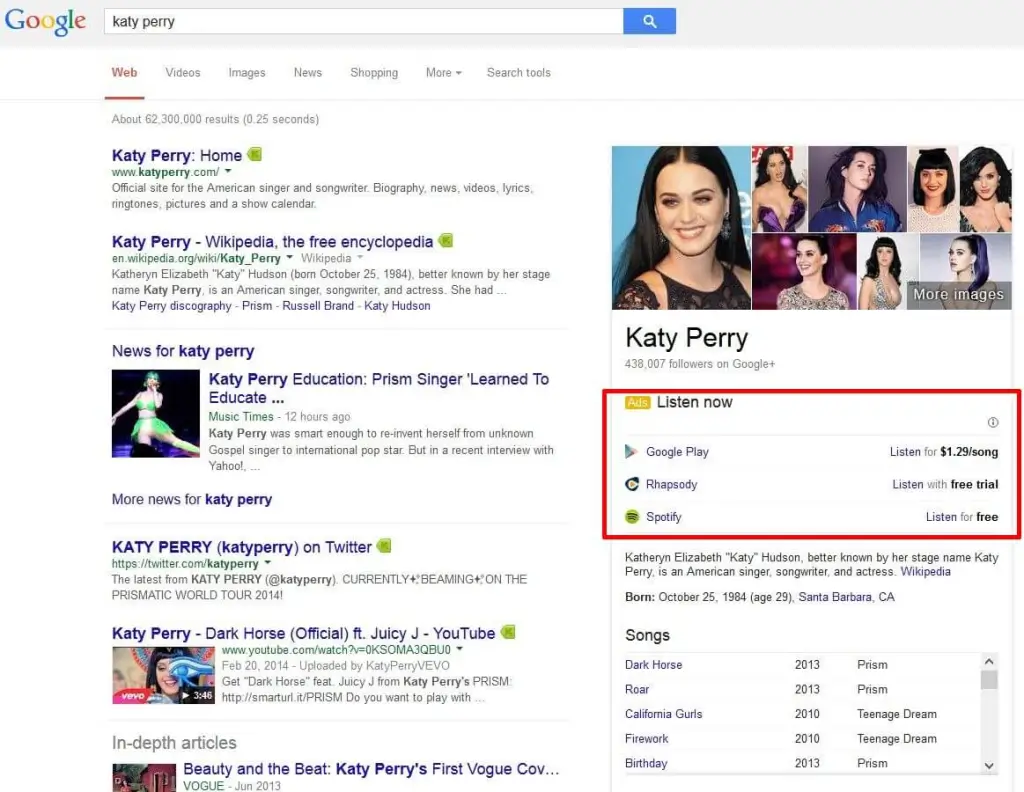
If you want to use Google Ads for music videos, consider YouTube ads. Here are the reasons:
Increase Video Views
YouTube ads are a powerful tool for increasing views and promoting your music to a wider audience. By investing in YouTube ads, you give your music a better chance of being discovered, enjoyed, and shared by others.
When users watch your YouTube ad long enough, it counts as a view on your video, which can significantly boost your view count. Many artists and music labels have found success using YouTube ads to enhance their video’s visibility and perceived value.
Additionally, YouTube ads are not only for newcomers; established musicians and major labels also use them to maximize the exposure of their music videos, especially during critical release periods.
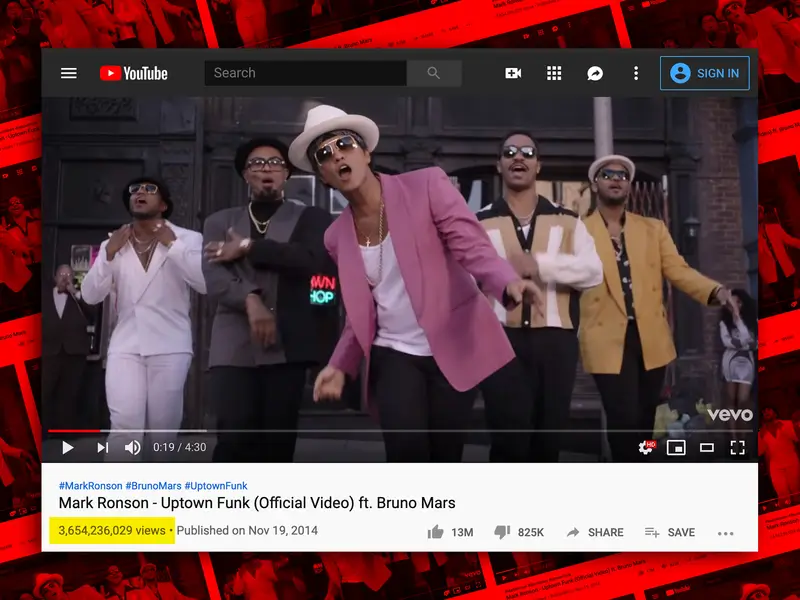
Enhance Online Presence
When users see a music video ad, it’s not just about boosting views; it’s about attracting listeners to the artist, especially for emerging and independent artists.
Promoting your music through a YouTube ad gives it a head start, creating an immediate impact and helping it catch on quickly. A YouTube ad can make a big splash on the first day of release, leading to increased views, a stronger online presence, and visibility through YouTube algorithms.
However, having a solid track and compelling video are still essential for a successful release.

Allow Ad Customization
One of the key benefits of YouTube ads is their flexibility to fit any budget, along with the ability to target specific audiences and choose preferred ad formats. Conducting A/B tests can also help determine which strategies yield the best results and maximize ROAS.
Below are some commonly used YouTube video ad formats that offer good ROAS.
Skippable In-stream Ads
Also known as skippable TrueView ads, allow viewers to skip the ad after a 5-second countdown. This model charges advertisers only if the viewer watches the ad for at least 30 seconds, resulting in cost-effective advertising with potentially higher ROI.
Non-skippable Ads
Require viewers to watch the entire ad without the option to skip. These ads typically last 15 to 20 seconds and can appear before, during (mid-roll), or after the video. Advertisers pay for every view or impression, which can be expensive and may lead to irritation among viewers who aren’t interested in the content. However, non-skippable ads can be impactful, especially for entertaining music videos, potentially boosting ROI.
Bumper Ads
Brief non-skippable ads lasting 6 seconds, typically placed at the end of a video. Similar to non-skippable ads, advertisers bid on a cost-per-thousand-clicks basis. Musicians with slightly larger budgets may find bumper ads suitable.
Video Discovery Ads
Also known as in-display ads, appear on the YouTube homepage, at the top of search results, or as related videos in the sidebar. These ads require viewers to click on them, allowing for longer-form content with no playtime limit. They are effective for increasing subscriber counts.
Which Ad Type is Recommended for Musicians?
Google Ads offers a versatile advertising platform with various formats including search ads, display ads, and video ads.
With Google Ads for musicians, this presents an opportunity to promote their work across a wide range of online platforms.
Search Ads
Visible in Google search results, are particularly effective for targeting specific keywords relevant to a musician’s genre or brand.
Imagine your music appearing right when someone searches for keywords related to your genre. Search ads are text-based and appear directly in Google search results.
By strategically selecting keywords like “[your genre] artist”, “[similar artist] recommendations”, or even “[music venue] upcoming shows”, you can target potential fans actively seeking new music that aligns with their tastes. This laser-focused approach ensures your music reaches the most relevant audience.

Display Ads
Provide a visual component, allowing artists to showcase album art, promotional images, or upcoming event details.
These ads can reach a broad audience as they appear on numerous websites.
Move beyond text with Display ads. These visually rich ads can showcase eye-catching album art, promotional photos for your latest release, or even upcoming tour dates. They appear on a massive network of websites and apps frequented by your target audience. Imagine your ad appearing on music review websites, popular blogs, or even social media platforms, grabbing the attention of potential fans who might not be actively searching for new music but are receptive to discovery.
Video Ads
Commonly found on YouTube, offers an engaging way to connect with potential fans, featuring music videos or exclusive behind-the-scenes content. This is a great choice if you have high-quality music videos or engaging behind-the-scenes content. Showcase your music, personality, and artistry to capture attention and introduce your sound to a broad audience on YouTube or even across the Google Display Network (websites and apps).
Promoting music videos on YouTube through skippable in-stream ads and in-feed video ads is among the fastest and most cost-effective methods. These ad formats and campaigns can be set up and activated using a Google Ads account.
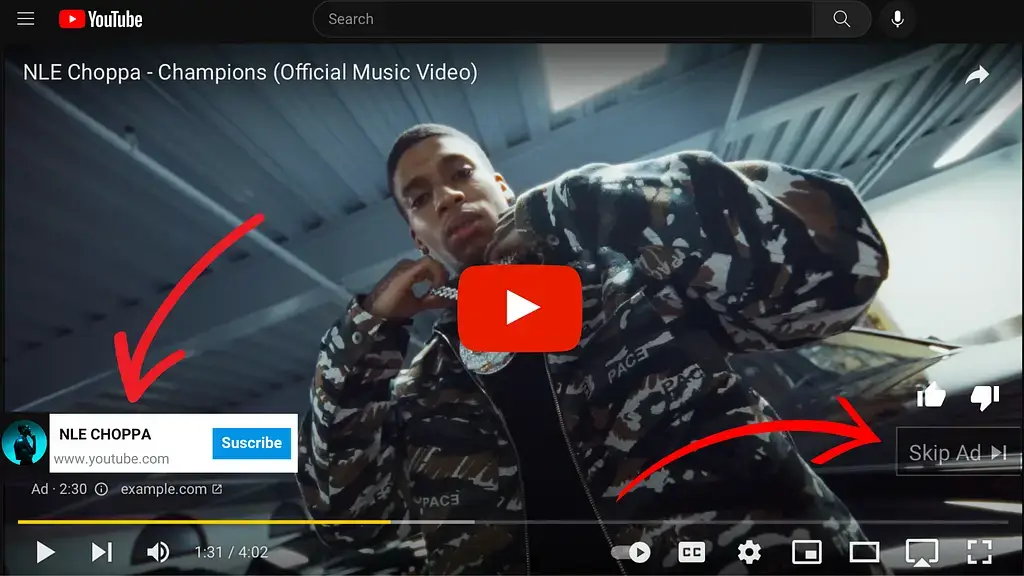
Is YouTube A Good Platform For Musicians?
The music industry’s move towards digital platforms means that artists must establish an online presence to thrive. YouTube is at the forefront of this shift with over 2 billion monthly users and a library of more than 70 million songs, surpassing its competitors. This makes it a crucial platform for artists to showcase their music.
Currently, more than 85% of music video views on YouTube are from users fully engaged, and 60% of individuals enjoy music on their mobile devices.
The music industry’s transition to digital platforms mandates that artists establish a strong online presence to thrive. YouTube leads this transition with its user base exceeding 2 billion monthly, boasting over 70 million songs, surpassing its competitors. This makes it a vital platform for artists to share their music.
As an example, BTS’ “Dynamite” amassed more than 101.1 million views within a 24-hour period. Similarly, Spanish car manufacturer SEAT achieved success using YouTube ads to enhance brand recall by 21%.
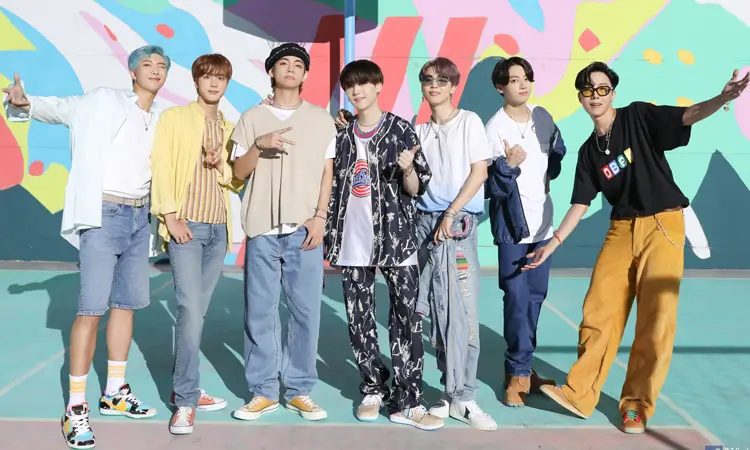
These transformations have a significant impact on musicians. Previously, success was measured by CD and record sales, but now it hinges on live performances and strategic music licensing. Artists and music industry professionals must leverage digital tools like Google Ads for music artists to remain pertinent and generate income in today’s music landscape.
How Much Does It Cost Musicians to Advertise on Google Ads?
Google Ads operates on a Cost-Per-Click (CPC) model, meaning you’re only charged when someone clicks on your ad, regardless of how many times it’s displayed.
On average, the cost per click (CPC) in the music industry can range from $0.50 to $3.00, depending on keyword competitiveness. For example, general keywords like “new music” might be less expensive than highly competitive ones like “music production services”. To lower costs, musicians can focus on local targeting, where costs might be lower compared to global targeting.
With a daily budget of $10 to $50, musicians can reach hundreds to thousands of views, depending on how well they optimize and manage their campaigns. For instance, according to a sample provided by Google Ads:
- Daily budget: $10
- Maximum cost-per-click bid: $0.50
- Average actual cost-per-click: $0.40
- Estimated clicks per day: 25
>>> Read more: How much do YouTube Ads Cost in 2024? [Detailed Breakdown]
How to Run YouTube Ads for Music Videos?
How to advertise your music on YouTube? Here are the steps to create a campaign on the platform:
Step 1: Set Up a Google Ads Account and Log In
Begin by creating a Google Ads account. You can register for one easily at this link: https://ads.google.com/home/
Step 2: Create a New Video Campaign
Within your Google Ads account, navigate to the left-hand sidebar and select “Video campaigns”. From there, click on “New Campaign” to proceed.

Step 3: Opt for Basic Video Campaign Settings
While Google Ads is typically used by companies aiming for e-commerce conversions, our objective is to increase views on our YouTube video. For this purpose, the most relevant campaign type would be “Brand Awareness & Reach”.
Next, select the “video” campaign type and opt for “Skippable In-stream” ads. Skippable In-stream ads are designed to showcase your video before other YouTube videos. Viewers have the option to skip your ad after 5 seconds. You will only incur charges if a viewer watches your ad for 30 seconds or longer.
YouTube considers 30 seconds as a view, which will be reflected in your view count. Any watch time below 30 seconds will not contribute to your view count and will be recorded as an “impression” in your backend metrics.

Step 4: Specify Your Campaign Name, Bid, and Settings
Assign a name to your campaign, keeping it intuitive for your own reference.
For this campaign, maintain the bidding strategy as “Target CPM”.
Establish your budget. You have the option to set a campaign budget or a daily budget. Opting for a campaign budget allows ad to distribute your budget evenly over the chosen campaign duration.
Alternatively, with a daily budget, Ads will adhere to your budget constraints each day. If you opt for a daily budget, consider setting an end date to avoid continual charges until you manually deactivate the campaign.
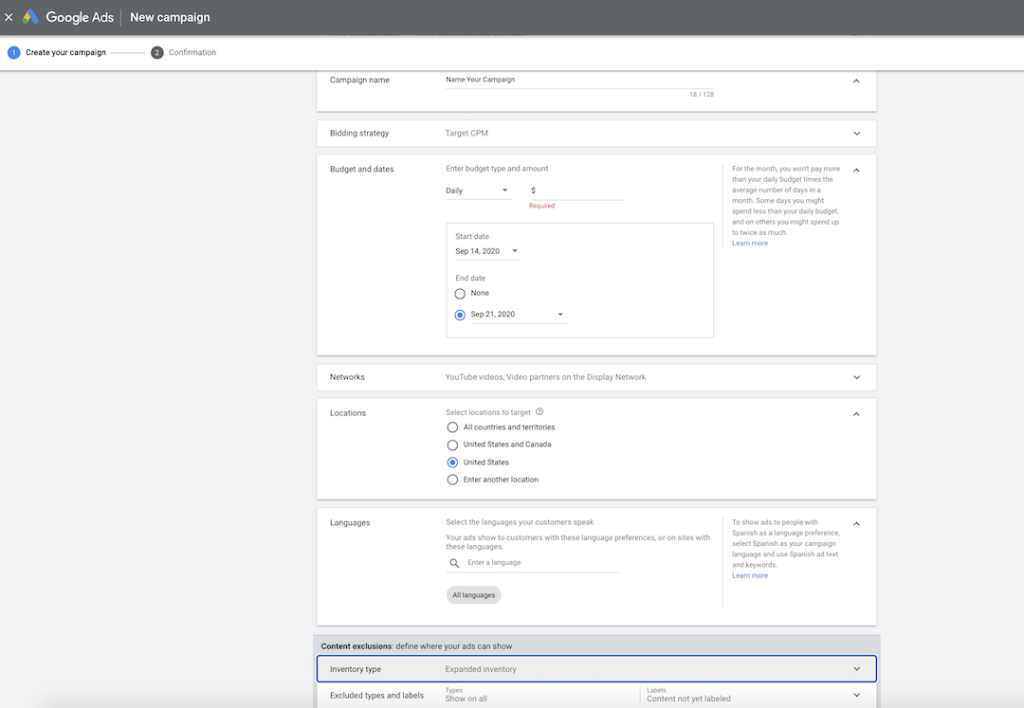
For Networks, uncheck “Video Partners on The Display Network” to ensure that videos are exclusively placed on YouTube. Specify the locations where you want the ad to appear and select any preferred languages.
Under content exclusions, ensure your videos do not display before any “mature content” and exclude YouTube videos embedded on external sites.
Step 5: Select Which Channels & Videos to Display Your Ad Before
In this YouTube Music Video promotion campaign, we’re positioning our music videos ahead of content from artists or channels that cater to a similar target audience as ours.
While you can also target keywords, demographics, and topics, I suggest focusing solely on placements initially to facilitate easier measurement of effectiveness. If you wish to advertise within a specific topic, consider creating a new campaign or ad group.
Occasionally, it’s beneficial to adjust demographics. For example, exclude individuals over the age of 65 if you believe your music won’t resonate with that audience.
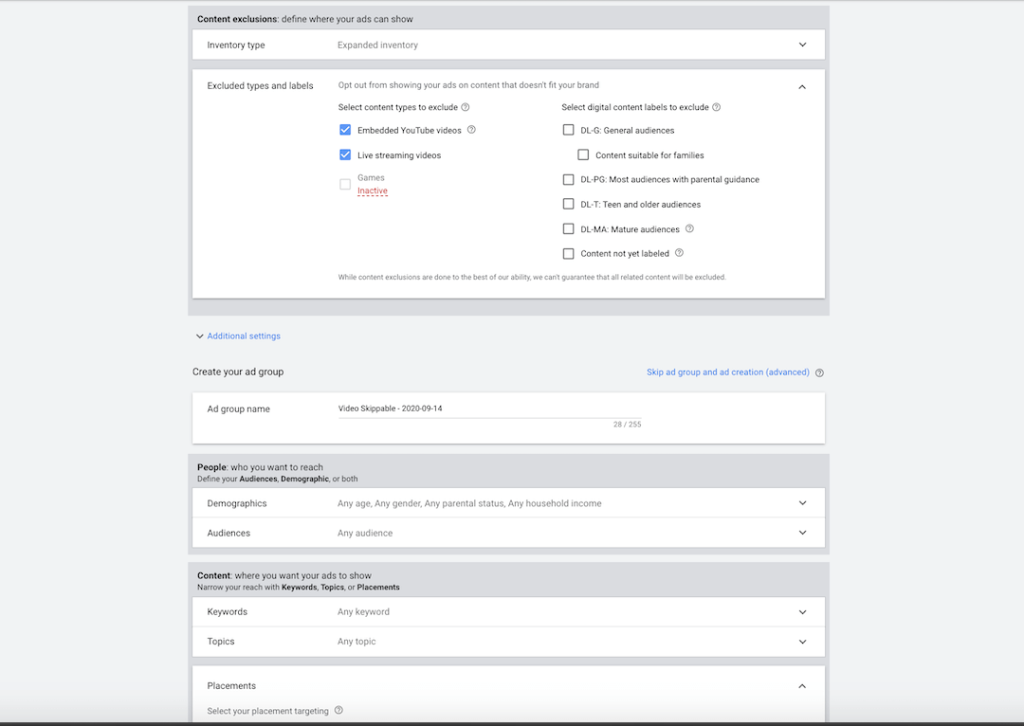
Selecting specific channels to showcase your video before is straightforward. Just navigate to the “Placements” section, where you can enter and choose channel names, and specific videos, or even paste URLs of particular channels or videos.
While targeting a single song or video may seem appealing, it could increase the cost of your ads. The more specific your targeting, the higher your bidding needs to be to secure placements.
The key is to strike a balance.
Step 6: Determine Your Bid
In our brand awareness campaign, we opted for a target CPM bidding strategy. This means you’re setting a bid for every 1000 impressions. If your target CPM is too low, your ad may not display as you won’t win in the ad auctions. Conversely, if it’s too high, you risk paying more than desired for an ad placement.
Bidding strategy can be complex, but for this tutorial, setting your CPM between $3-$5 is a good starting point. Google also provides guidance in the right-hand sidebar to assist you.
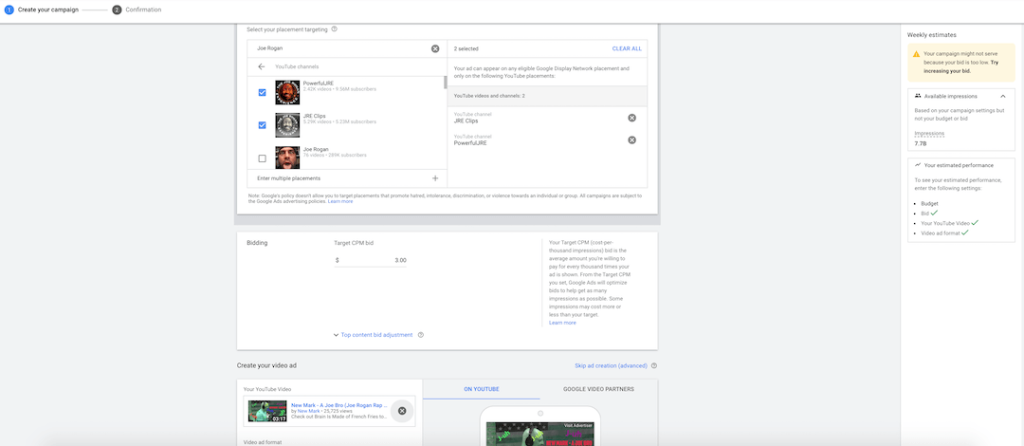
Step 7: Craft Your Ad
As your video is already on YouTube, setting up your ad is straightforward. Simply paste the URL of your YouTube video into the designated field, and you’re almost set.
For the “Final URL”, you can use either the URL of your video or the URL of your channel. This determines where users will be directed when they click on your ad. Regardless of whether users click on your ad or watch your video in full without skipping, your view count will rise.
A preview on the right-hand side displays how your skippable in-stream ad will appear.
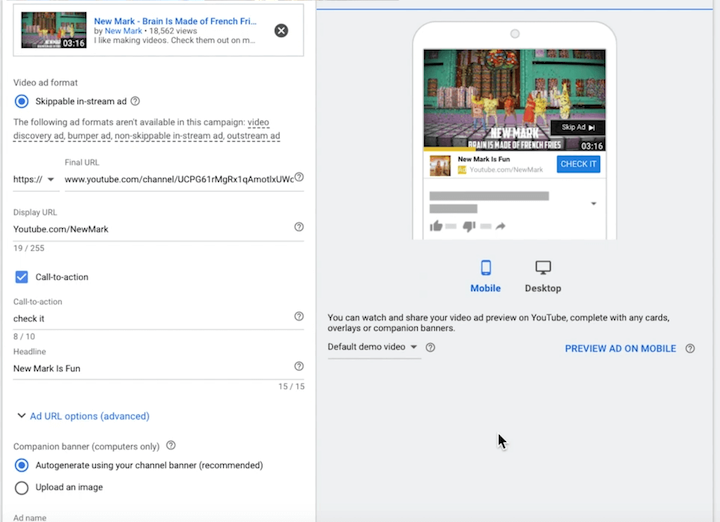
How to Optimize Your Music Video YouTube Advertising Campaign?
Here are 15 steps to enhance your YouTube advertising campaign for your music video:
- Choose the “product & brand consideration” campaign option.
- Opt for “influence consideration”.
- Name your YouTube advertising campaign (e.g., SongName $15/week).
- Specify your budget and campaign duration (e.g., $5/day for a week).
- Select the geographic locations for your YouTube advertising (e.g., US, Australia, etc.).
- Opt for “expanded inventory” to maximize reach.
- In the “related videos” section, link to popular songs similar to the one you’re promoting.
- Choose the appropriate age demographics for the YouTube advertising, if necessary.
- Select relevant audio segments (e.g., Music Lover, Rap Fans, etc.).
- Choose topics (e.g., Arts & Entertainment –> music videos).
- Set the bid cost (e.g., $0.01/view for maximum exposure).
- Link your YouTube video.
- Set the ad format to “skippable in-stream” for lower cost per view.
- Create a compelling call-to-action (CTA) and set it to “Listen Now”.
- Craft an attention-grabbing headline (e.g., New Rap Banger!).
- These methods are highly effective and guaranteed to increase your visibility!
YouTube Ads for Musicians Examples
Creating a compelling advertisement for your music video on YouTube is akin to an art form, potentially as demanding as producing the original music video. The ideal music video ad is one that seizes viewers’ attention and ultimately leaves them craving more.
But what exactly are the essential elements of a successful music video ad?
Example 1: Focus on the first 3 seconds
As demonstrated in this video, the opening 5 seconds of the advertisement for pop icon Britney Spears’ 2011 release, “I Wanna Go”, effectively captivate viewers’ attention.
In today’s fast-paced world, attention spans are shrinking. While music video ads typically span from 15 to 30 seconds, experts suggest that the initial 3 seconds are crucial in grabbing viewers’ interest and influencing whether they continue watching the entire ad.
It’s imperative to make those initial seconds count. Craft a compelling start that entices viewers to stay engaged throughout the ad and beyond.
Additionally, keeping the total ad duration under 15 seconds offers 2 benefits:
- Shorter ads are more likely to leave viewers eager to watch the full-length music video.
- A 15-second ad can be used on platforms like Instagram stories and in Facebook marketing, broadening the reach of marketing efforts beyond YouTube.
Example 2: Make Clever Use of Available Footage
The popular boyband BTS creatively incorporated B-roll footage into a memorable advertisement for their 2017 single, “Spring Day”.
With your music video already prepared or released, you likely have a wealth of footage at your disposal. Select the most captivating visuals from your existing collection of still images and videos. This not only ensures that your advertisement mirrors the style and atmosphere of your primary music video but also proves to be more cost-effective than shooting new footage.
Tip from Mega Digital: Delve into the B-roll footage leftover from your primary music video to discover a wealth of visuals aligned with the target video your ad aims to highlight.
Example 3: Test Multiple Versions
Korean artist Psy launched 2 distinctly different music video advertisements prior to the release of the now iconic 2012 Gangnam Style music video. As indicated by the captions, ad Version #1 garnered three times more views than Version #2 – although 6.6 million views for Version #2 is still impressive!
Let’s be honest—when it comes to music video ads, there’s no guaranteed formula for success.
Savvy musicians often release multiple versions of music video ads for the same song, using viewership data to determine which ad resonates most with their audience in terms of interest and engagement.
It’s highly recommended to create at least two variations of a music video ad, though aiming for 3 versions is not uncommon. The one that quickly accumulates the most views should be prioritized for further promotion.
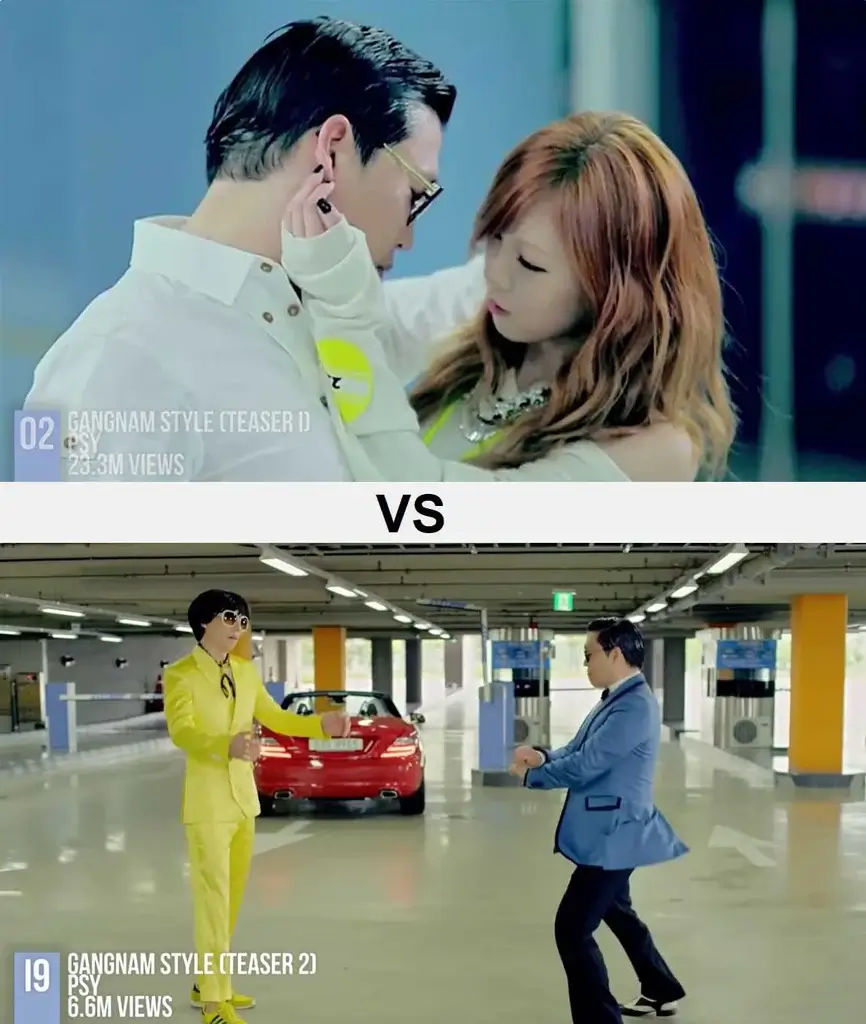
Example 4: Emotion plays a crucial role
Nicki Minaj, a prominent figure in hip-hop, effectively established an emotional bond with viewers in her advertisement video for her 2014 song “Feeling Myself”, featuring Beyoncé Knowles. The ad portrayed the close bond and camaraderie among girlfriends.
It’s imperative that your advertisement elicits an immediate emotional reaction from viewers. This could range from nostalgic warmth to ecstatic happiness or even subtle unease. However, fostering this emotional connection is what will turn casual viewers into eager fans eagerly anticipating your full music video.
Wrap up
Don’t just play your music, blast it out to the world! Google Ads lets you target the perfect audience for your sound, from enthusiastic genre fans to those searching for artists like you. With budget control and detailed tracking, you can see exactly how your music is resonating and make adjustments for ultimate success. So crank up the volume on your music career with Google Ads for musicians.








